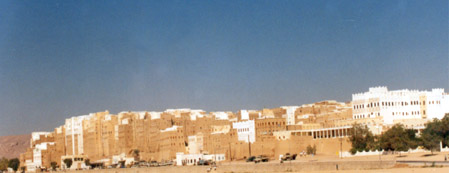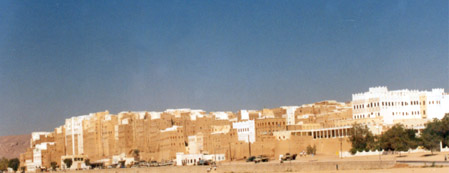
Hadramaut: Civilization & History [Archives:2001/41/Culture]
October 8 2001

Prepared for bublishing by
Ismael Al-Ghabiri
Yemen Times
Hadramaut is divided into two parts:
a – Coastal Hadramaut which includes the coastal area of Mukalla, Shahir and others.
— Internal Hadramaut which includes the valley districts, Saiyoun, Tarem, Shebam and the valley districts that begin in the al-A’ain valley, passing through the small villages up to al-Hawra, al-Qaten and al-Ainin.
Hadramaut has a total area of 155,489 km and its shore is considered to be an extension of the southern coastal region which stretches 6,200 km from Bab al-Mandab Strait to the coastal border of the Sultanate of Oman. Hadramaut valley represents a distinguished typographical phenomenon, as it is the greatest valley of Yemen and runs in parallel to the southern coastal region in southern Arabia.
Water Resources
The location of Hadramaut within the domain of the dry equatorial climate has effected the water resources of the region as there exists no permanent surface water, except for some valleys with springs.
Mukalla
Upon the establishment of the Cassadit dynasty in 1115 Hijri, Mukalla used to have the name al-Khisah. It gained much renown and supremacy when it replaced Shahir as the capital of Mukalla in 615 Hijri. Al-Ghwaizi castle is one of the most distinguished monuments of the city, though it is in dire need for renovation. Additionally, in Mukalla there is the famous Sultan library, containing a great deal of scientific books.
Shahir
Shahir is one of the oldest cities in the world and has been the scene for many battles between its inhabitants and the Portuguese invaders. Shahir is also one of the greatest cities of the governorate of Hadramaut and the oldest port of the governorate. Throughout history Shahir has been the capital of many dynasties that have taken place in the region. Shahir was invaded by the Qa’aiteens in the second half of the nineteenth century. One of the most distinguished monuments of Shahir are al-Aydrus and al-Khur gates, which were built by the Qa’aiteens, who also built a fence of 3.3 km circumference, 5.7 meters height and 1.15 meter width. Some of the ruins of this fence are still apparent up to this very day. Abubakar al-Mehthar, the famous Yemeni poet, lived in Shahir and composed many beautiful poems and lyrics about the city.
Saiyun
The town of Saiyun is 200 miles from Mukalla, 22 from Tarim and 13 miles from Shibam. It was built by Mua’awia al-Kindi and later was declared by Sultan Badir Daruish to be the capital of his dynasty. It is distinguished by its mild, temperate climate and its ancient mosques.
Shibam
Shibam is as old as history. The most important thing about Shibam are the old buildings which are consider to be the first skyscrapers in the world. Shibam was named after its king Shibam bin Hareth bin Saba junior. Shibam used to be a commercial center emerging within the same period as Ma’ayn Dynasty in the 14th Century BC.
Ghail Bawazir
Ghail Bawazir was named after sheikh Abdurahman Mohammed bin Omar Bawazir, who settled in the region at the beginning of the 7th century Hijri. Sheikh Bawazir built a religious institute in 1320 Hijri and the first intermediate school was built in 1944.
Tarim
Tarim is one of the ancient Yemenite cities which was mentioned in the old Musnad inscriptions. It not only used to be on the route of frankincense and myrrh caravans and during the Islamic era, it was also one of the most important cities in Hadramaut valley. One of the most distinguished monuments of Tarim is the al-Mihthar mosque, built in 833 Hijri.
——
[archive-e:41-v:2001-y:2001-d:2001-10-08-p:./2001/iss41/culture.htm]


